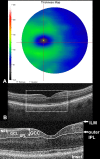Ganglion Cell Complex Analysis in Glaucoma Patients: What Can It Tell Us?
- PMID: 32099501
- PMCID: PMC6999543
- DOI: 10.2147/EB.S226319
Ganglion Cell Complex Analysis in Glaucoma Patients: What Can It Tell Us?
Abstract
Glaucoma is a group of optic neuropathies characterized by a progressive degeneration of retina ganglion cells (RGCs) and their axons that precedes functional changes detected on the visual field. The macular ganglion cell complex (GCC), available in commercial Fourier-domain optical coherence tomography, allows the quantification of the innermost retinal layers that are potentially involved in the glaucomatous damage, including the retinal nerve fiber (RNFL), ganglion cell and inner plexiform layers. The average GCC thickness and its related parameters represent a reliable biomarker in detecting preperimetric glaucomatous damage. The most accurate GCC parameters are represented by average and inferior GCC thicknesses, and they can be associated with progressive visual field loss. Although the diagnostic accuracy increases with more severe glaucomatous damage and higher signal strength values, it is not affected by increasing axial length, resulting in a more accurate discrimination of glaucomatous damage in myopic eyes with respect to the traditional RNFL thickness. The analysis of the structure-function relationship revealed a good agreement between the loss in retinal sensitivity and GCC thickness. The use of a 10-2° visual field grid, adjusted for the anatomical RGCs displacement, describes more accurately the relationship between RGCs thickness and visual field sensitivity loss.
Keywords: retinal ganglion cells; retinal nerve fiber layer; spectral-domain optical coherence tomography; standard automated perimetry.
© 2020 Scuderi et al.
Conflict of interest statement
The authors report no conflicts of interest in this work.
Figures


References
Publication types
LinkOut - more resources
Full Text Sources

